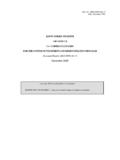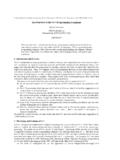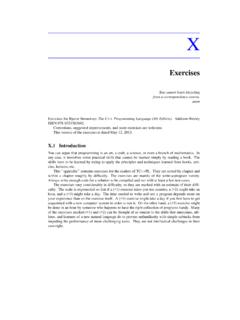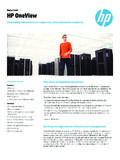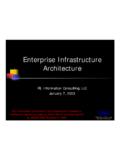Transcription of Software Development for Infrastructure - Bjarne Stroustrup
1 COVER FEATURE47 JANUARY 2012 Published by the IEEE Computer Society0018-9162/12/$ 2012 IEEE The implication puts a new emphasis on the old challenge to Software developers: deliver code that is both correct and efficient. The benefits achievable with better system design and implementation are huge. If we can double the efficiency of server Software , we can make do with one server farm instead of two (or more). If we can double the efficiency of critical Software in a smartphone, its battery life almost doubles. If we halve the bug count in safety-critical Software , we can naively expect only half as many people to sustain view contrasts with the common opinion that human effort is the factor to optimize in system develop-ment and that computing power is essentially free.
2 The view that efficiency and proper functioning are both para-mount (and inseparable) has profound implications for system design. However, not all Software is the same it doesn t all live under the same conditions and with the same constraints, so we should adjust our Software de-velopment techniques and tools to take that into account. Similarly, we should adjust our expectations of Software developers. One size doesn t fit all when it comes to soft-ware, Software Development , or Software call Software where failure can cause serious injury or serious economic disruption Infrastructure Software .
3 Such Software must be dependable and meet far more stringent reliability standards than regular Software . Because or-dinary personal computers and smartphones are used as platforms for applications that also serve as Infrastructure in my operational use of that word, the fundamental soft-ware of such platforms is itself Infrastructure , as is the Software used to deploy it. For example, if the Software that updates the operating system on a cell phone malfunc-tions, crucial calls might not get through, and someone could be injured or bankrupted.
4 Our lives are directly affected by Software correct-ness and efficiency: A datacenter, as run by a major corporation such as Amazon, AT&T, Google, or IBM, uses about 15 MW per day (equivalent to 15,000 US homes) and the set-up cost is about US$500 million. In 2010, Google used million MW to run its A smartphone battery lasts for less than a day if used a lot. We re surrounded by systems that, if they fail, can injure people or ruin them economically. Examples include automobile control systems, banking soft-ware, telecommunication Software , and just about any industrial control Software .
5 We can t send a repairman to fix a Software bug in a space probe, and sending one to reprogram a ship s engine on the high seas is impractical. Trying to fix a Software error in a consumer device, such as a camera or a TV set, typically isn t Software needs more strin-gent correctness, reliability, efficiency, and maintainability requirements than non- essential applications. This implies greater emphasis on up-front design, static struc-ture enforced by a type system, compact data structures, simplified code structure, and improved tool support.
6 Education for Infrastructure and application developers should differ to reflect that emphasis. Bjarne Stroustrup , Texas A&M UniversitySoftware Development for InfrastructureThe increases in demands on hardware and Software will continue: human expectation grows even faster than hardware FEATURE compUteR 48 One of my inspirations for quality Infrastructure soft-ware is the requirement AT&T placed on switches in its telecommunication system backbone: no more than two hours of downtime in 40 years ( ). hardware failure, loss of main power, or a truck colliding with the building that houses the switch isn t an excuse.
7 To reach such goals, we need to become very serious about reliability, which is a vastly different mindset from we must get something anything to market first. DO MORE WITH LESSS oftware reliability is improving. If it were not, we would have been in deep trouble already. Our civilization runs on Software . If it were not for computerized systems, most of us would starve. Our dependence on computerized systems is increasing, the complexity of those systems is increasing, the amount of code in those systems is increas-ing, and the hardware requirements to run those systems are increasing.
8 But our ability to comprehend them is not. Many of the improvements in system reliability over the years have been achieved through deep layering of Software , each layer distrusting other Software in the system, checking and rechecking Further-more, layers of Software are used to monitor hardware and, if possible, compensate for hardware errors. Often, applications are interpreted or run in virtual machines that intentionally isolate them from hardware . These efforts have resulted in systems that are more reliable, but huge and less well understood.
9 Another contribution to the improved reliability has come from massive testing. The cost of maintain-ing and deploying Software is increasing. The increases in demands on hardware and Software will continue: human expectation grows even faster than hardware consumers of computing power are tools and languages aimed at making programming easier and less error-prone. Unfortunately, many such tools move deci-sions from design time to runtime, consuming memory and processor cycles. We compensate for lack of design-time knowledge by postponing decisions until runtime and adding runtime tests to catch any compensate for our lack of understanding by increasing our requirements for computing power.
10 For ex-ample, my word processing Software is so sophisticated that I often experience delays using it on my dual-core computer. But processors are no longer getting faster. The number of transistors on a chip still increases according to Moore s law, but those transistors are used for more processors and more memory. Also, we depend more and more on energy-consuming server farms and on portable gadgets for which battery life is an issue. Software efficiency equates to energy and energy efficiency require improvements in many areas. Here, I discuss implications for Software .

